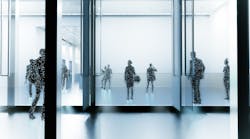Experts agree that remote work is here to stay. With an ever-increasing reliance on digital platforms to collaborate and complete tasks in the hybrid work model, the metaverse and IoT (Internet of Things) technologies already have a significant impact on our daily lives.
IoT technologies have seen rapid development in the consumer and residential spaces for convenience, security, and energy conservation, but have more recently made tremendous strides in the workplace. In addition to increasing productivity and elevating the office environment with modern convenience and sophistication, these innovative systems help offices reduce waste, optimize operations, foster community, and monitor processes more effectively.
Another advancement comes in the form of the metaverse, which carries massive potential in the workplace to improve company culture and mentorship. It also presents the added benefit of improving environmental impact and promoting healthier workspaces for staff.
The Impact of the Metaverse on Remote Work
The metaverse provides an opportunity for business leaders to reduce their carbon footprint by eliminating or reducing commuting, travel, and building emissions while still achieving the same level of business ROI as working in-person. According to statistical analysis reported by Intuition, after the global pandemic, 92% of people surveyed expect to work from home at least one day per week and 80% expected to work at least three days from home per week. The same report found that “66% of executives considered reorganizing company office space to accommodate hybrid work.” With its ability to support remote and hybrid working environments while connecting employees in digital space, the metaverse can help businesses improve their carbon footprints and introduce sustainable practices.
The metaverse provides a new, culture-enhancing vehicle for hybrid work by bridging the gap between those working remotely and those in the physical workplace. Allowing employees to engage and collaborate from home, users operate customized avatars in a digital environment to complete tasks and conference with each other.
[Related: How Blockchain Technology Will Transform the Built Environment]
The workplace metaverses can be built as a digital twin of the physical workspace, giving remote employees an immersive representation of the physical office where they can meet with their in-person colleagues while offsite. Rather than relying on remote conferencing for every meeting, teams can develop bonds and collaborate in the metaverse. Further, metaverse environments are also impression-rich places to welcome guests, clients, peers, and beyond while perfectly displaying company culture and brand. This replacement of physical appointments for a virtual workspace requires fewer resources and reduces the need for in-person business travel and daily commuting. The metaverse can be just as effective as working in the physical office and eases the effects of reduced collaboration within remote-only teams.
Another benefit of digital twin technology is it allows us to optimize the physical world by examining it through the lens of virtual reality. Using smart technology and robust analytics, architects and designers can make more accurate predictions about factors such as carbon emissions, air quality control, energy expenditures and other elements impacting workplace resource allocation. This thorough analysis can be used to make more informed decisions, helping companies improve ESG efforts and reduce waste.
IoT, Energy Conservation, and User Health
Advancements in IoT technologies and artificial intelligence (AI) have continuously transformed how we operate on a daily basis. From smart home assistants to wearable tech and a plethora of voice-activated gadgets, IoT has expanded rapidly and the number of such devices is expected to triple by 2023. However, as the workplace becomes a new playing field for smart tech, employers are acting on the opportunity to reduce energy use and support ESG efforts. In fact, analysis by the World Economic Forum indicates that 84% of current IoT deployments are “addressing or have the potential to address” the UN’s Sustainable Development Goals.
One way that IoT enables environmentally-friendly and cost-effective measures is by tracking the usage of lighting and high-energy appliances such as printers, coffee makers and other equipment. Using occupancy sensors in coordination with smart thermostats, lighting and integrated appliances enables data-driven and cost-effective energy consumption through actions such as optimizing or powering down these systems automatically during low-usage times. This process has the added benefit of reducing operating costs, while data from room sensors enables smart scheduling tools and reports on trends for things like meeting frequency, attendance and the need for volume or size of communal spaces.
IoT technologies can also be used to make the physical workplace healthier by monitoring and controlling temperature, humidity and air quality levels to create a safer post-pandemic workplace. With these systems in place, office managers and building owners can receive in-depth data about the wellness and comfortability of their buildings (even if they’re remote), including metrics on germicidal cleaning, virus detection, air quality, daylight harvesting, shade controls and smart thermostat integration. When employees want or need to go into the office, they can be assured that their health and wellness are taken into consideration.
Creating the Future Sustainable Workplace
As we continue to see advancements in technology that decrease energy consumption and build healthier workspaces, the importance of IoT and metaverse technologies will continue to play an important role in accelerating positive change. With workplace priorities shifting more toward sustainability, this surge in improved systems will only continue over the next few years. Artificial Intelligence and IoT technologies are being used to chart and utilize insights on energy usage in commercial buildings and office spaces to simultaneously protect the environment and improve the human experience.
Read next: New Technology Solution Bridges Physical, Digital Workplace in the Metaverse

